Malfunctions, Causes and Remedies
Installation and maintenance information
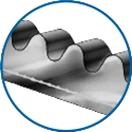
HARDENED, POLISHED EDGES
Cause
- Pulleys do not align
- Reinforcing members damaged due to improper installation
- Incorrect set configuration
Remedy
- Check the drive, align any misaligned pulleys and install new belt set correctly
- Change the belt and install belt correctly
- Always replace the entire belt set
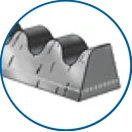
HEAVY EDGE WEAR, BRITTLE EDGES
Cause
- Excessive slip
- Pulleys do not align
- Worn pulley grooves
Remedy
- Change belt, set correct tension
- Check drive, align non-aligned pulleys or replace them if necessary
- Align or replace pulleys, change belt
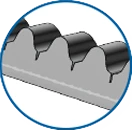
BREAKAGE AND FRAYING OF BASE COMPOUND / BELT SECTION
Cause
- Belt tension too low/high
- Lifetime exceeded
- Foreign bodies
Remedy
- Change belt
- Set correct tension

BELT RUNNING NOISE
Cause
- Tension too low
- Lifetime exceeded
Remedy
- Re-tension or change belt
- Change belt
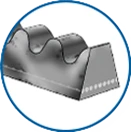
CONTAMINATION OF THE BELT
Cause
- Leakage of the engine or engine compartment
(such as leakage of oil, antifreeze, etc.)
Remedy
- Remove leak, change belt

UNEVEN WEAR OF THE BELT SECTION
Cause
- Pulleys do not align
- Strong belt vibration
Remedy
- Check drive, align non-aligned pulleys or replace them if necessary, change belt
- Check tension, retention belt if necessary
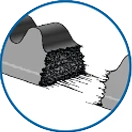
CRACK IN BELT AFTER SHORT RUNNING PERIOD
Cause
- Reinforcing members damaged due to improper installation
- Tension set too high
Remedy
- Change the belt and install belt correctly
2. Change belt, set correct tension
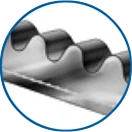
HARDENED, POLISHED EDGES
Cause
- Improper installation tension
- Reinforcing members of the belt damaged due to improper installation
Remedy
- Change belt, set correct tension
- Change the belt and install belt correctly
- Always replace the entire belt set

HARDENED, POLISHED EDGES
Cause
- Improper installation tension
- Reinforcing members of the belt damaged due to improper installation
Remedy
- Change belt, set correct tension
- Change the belt and install correctly
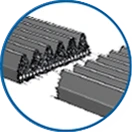
CRACK IN BELT AFTER SHORT RUNNING PERIOD
Cause
- Reinforcing members damaged due to improper installation
- Tension set too high
Remedy
- Change the belt and install belt correctly
- Change belt, set correct tension
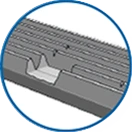
BREAKAGE AND FRAYING OF BASE COMPOUND / BELT SECTION
Cause
- Belt tension too low/high
- Lifetime exceeded
- Foreign bodies
Remedy
- Change belt, set correct tension
- Change belt
- See Remedy 2

FAULTY SYSTEM COMPONENTS
Cause
- Bearing clearance
- Damaged tread surface
Remedy
- Replace guide idler pulley, tension pulley, and/or guide idler
- See Remedy 1
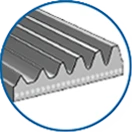
UNEVEN WEAR OF THE BELT SECTION
Cause
- Pulleys do not align
- Strong belt vibration
Remedy
- Check drive, align non-aligned pulleys or replace them if necessary, change belt
- Check tension, retention or change belt if necessary
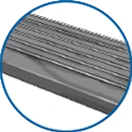
CONTAMINATION OF THE BELT
Cause
- Leakage of the engine or engine compartment
(such as leakage of oil, antifreeze, etc.)
Remedy
- Remove leak, change belt
CONTAMINATION OF THE BELT
Cause
- Leakage of the engine or the engine compartment
(such as leakage of oil, antifreeze, etc.)
Remedy
- Remove leak, change belts

BELT RUNNING NOISE
Cause
- Tension too low
- Lifetime exceeded
Remedy
- Re-tension or change belt
- Change belt
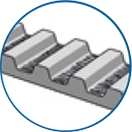
WEAR OF THE FABRIC OF THE WEB
Cause
- Tension set too high
- Worn timing belt pulley
Remedy
- Change belt, set correct tension
- Replace timing belt pulley, change belts

WEAR OF THE TOOTH FLANK/ROOT CRACKS AND TOOTH SHEARING
Cause
- Tension too high/low
- Action of foreign bodies
- Fixed timing belt pulley and/or tension idler
Remedy
- Change belt, set correct tension
- Remove foreign objects, ensure the cover is positioned properly, change belt
- Detect causes ( e.g., faulty bearing) and find remedies, change belt
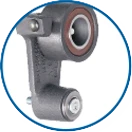
FAULTY SYSTEM COMPONENTS
Cause
- Bearing play
- Damaged tread surface
Remedy
- Replace guide idler pulley, tension pulley, and /or guide idler
- See Remedy 1

TIMING BELT RIPS
Cause
- Foreign bodies in the drive
- Action of foreign substances
- Installation tension too high
- Kinking the belt before or during assembly
Remedy
- Remove foreign bodies/substances, change belt
- Change belts, ensure the cover is positioned properly
- Change belt, set correct tension

CRACKING ON BELT TOP SURFACE
Cause
- Ambient temperature too high/low
- Action of foreign substances
- Stiff back bend idler
- Ageing
Remedy
- Detect causes ( e.g., cooling capacity test) and find remedies, change belts
- Change belts, ensure the cover is positioned properly
- Replace pulley, change belts
- Change belt
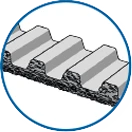
WEAR ON EDGES
Cause
- Absence of axially parallel setting; belts run against flanged pulley
- Wheels are not set axially or timing belt cannot run aligned
- Flanged pulley has an imperfection, bearing play of components
- Bearing play of components
Remedy
- Check drive, align non-aligned pulleys or replace them if necessary; change belt
- See remedy 1
- Replace-tension/guide idler pulley
- See Remedy 3
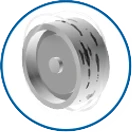
NOISE
Cause
- Tension too high: Belts screech, squeal
- Tension too low: Belt hits against the cover
Remedy
- Set correct tension
- See Remedy 1
SAFETY TIPS
- Please observe installation regulations and safety instructions supplied by the manufacturer of the car.
- Please only perform installation of the drive belts with special tools and a minimum exertion of force! The use of screwdrivers, crowbars or such tools is prohibited.
- Do not treat the control unit components with corrosive chemicals. Belts must not come into contact with oil or similar substances.
- Fill in the timing belt adhesive label legibly and attach it firmly in the engine compartment.
- If individual components are faulty, the other components must also be replaced.
STORAGE
- Store timing belts dry and at +15 to +25ºC.
- If stored properly, the level of quality will be maintained for years.
- If stored improperly, e.g. through exposure to oxygen, light, extreme temperatures or moisture, the physical properties can change and the belts will become unusable.
IMPORTANT
Until they are used, the drive belts should remain in their original packaging and stored free of any tension. When stacking, a height of 300 mm should not be exceeded or deformation may occur.
